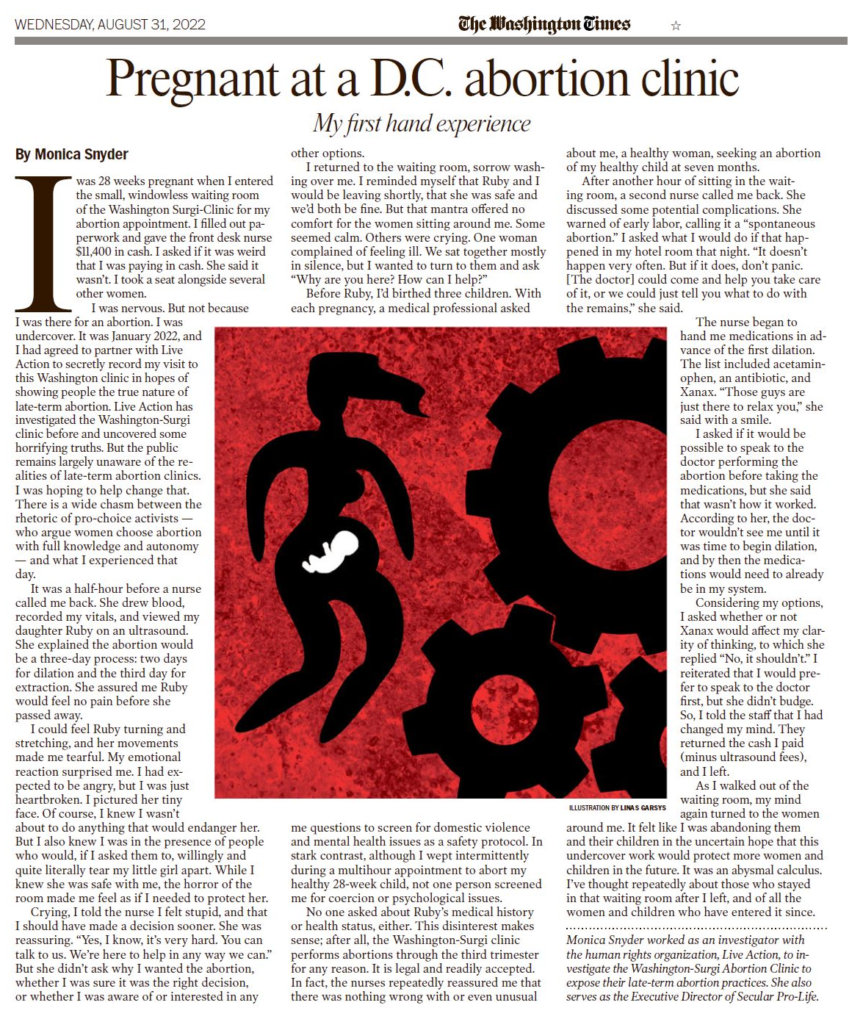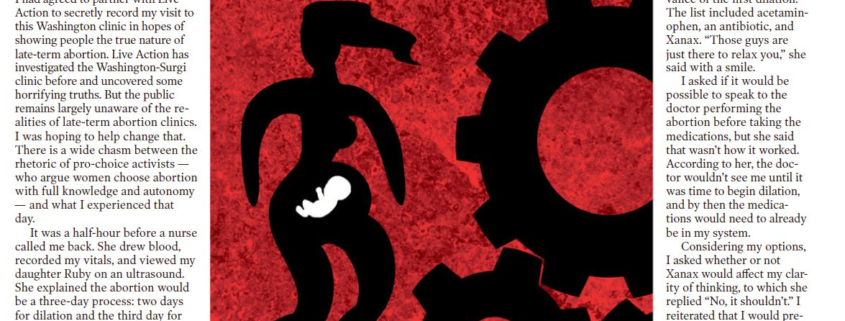My appointment for an abortion at 28 weeks
[Post-publication update, May 2023: I spoke in more detail about this clinic visit in a podcast episode with Equal Rights Institute]
On January 12, 2022, I was 27 weeks and 1 day pregnant when I called the Washington Surgi-Clinic in Washington DC to schedule an abortion for the following week. The woman on the phone was upbeat and friendly. She offered me an appointment for January 20, acknowledging by then I would be 28 weeks and 1 day along. She explained the abortion would be a three day process and would require $11,400 payment on the first day (cash or credit card only, no personal or cashier’s checks accepted). I made the appointment.
Of course I had no intention of getting an abortion. I was headed to the Washington Surgi-Clinic because I had agreed to work undercover for Live Action. The general public has the impression that late-term abortions are all or almost all for dire medical emergencies (woman’s life is in danger, fetus has a fatal anomaly, etc.). Through Secular Pro-Life, I’ve long highlighted the evidence that this is a myth: data suggest most abortions 21 weeks or later are on healthy fetuses carried by healthy women. Live Action gave me the opportunity to verify that reality firsthand. They released parts of the footage here:
On January 20, I entered a small, windowless waiting room where several other women were seated. I checked in and a nurse had me fill out paperwork and sign forms. The nurse asked me how I’d like to pay today, and I gave her an envelope with $11,400 in cash. I’d never carried that much cash at once before. She asked if I was making the entire payment in cash, and I said yes and, a bit nervous, asked if that was weird. She said it wasn’t. I took a seat in the waiting room alongside several other women.
In half an hour an older nurse called me back. She drew some blood, recorded my vitals, and viewed my daughter Ruby on ultrasound. She explained the abortion would be a three day process: two days for dilation and a third day for “extraction.” She assured me Ruby would feel no pain before she passed away.
[Read more – New peer-reviewed article: Fetal Pain in the First Trimester]
I could feel Ruby turning and stretching, and her movements made me tearful. My emotional reaction surprised me. Knowing I would be secretly recording, I had expected to be on edge. Knowing I was interacting with people who provide elective late-term abortions, I had expected to be angry. But I was neither. I was just heartbroken.
I pictured Ruby’s tiny face. Of course, rationally, I knew I wasn’t about to do anything that would be a danger to her. But I also knew I was in the presence of people who would, if I asked them to, willingly and quite literally tear my daughter apart. Whatever I understood intellectually, a more instinctive part of me felt as if Ruby were under threat. When I contemplated what I could legally ask them to do to my little girl, I didn’t need to pretend to be a tearful patient. I was genuinely distraught.
Crying, I told the nurse I felt stupid. I said that I should have made a decision sooner. The nurse was reassuring. “Yes, I know, it’s very hard. You can talk to us. We’re here to help in any way we can.” She was kind. I genuinely liked her. She had a maternal air about her and seemed to really care about comforting the women she was working with. I easily believe that she believes she is helping people. Nevertheless, she didn’t ask why I wanted the abortion, whether I was certain it was the right decision, or whether I was aware of or interested in any other options.
Before Ruby, I had birthed three children. With each pregnancy, I arrived at my prenatal appointments feeling cheerful, if occasionally a bit anxious, and at each appointment medical professionals asked me questions to screen for domestic violence and mental health issues, as standard safety protocols. In contrast, although I wept intermittently during an hours-long appointment to abort my healthy 7 month child, at no point did staff screen me for coercion or psychological issues.
[Read more – The abortion and mental health controversy: A comprehensive literature review]
Neither did clinic staff ask anything about Ruby’s medical history or health status. This uninterest makes sense; after all, the Washington-Surgi clinic will perform a 28-week abortion for no medical reason. It is legal and readily accepted. Indeed, the nurses reassured me that there was nothing wrong with or even unusual about my seeking abortion so late in pregnancy without medical indication.
I returned to the waiting room, sorrow washing over me. I reminded myself that Ruby and I would be leaving shortly, that she was safe, that we would be fine. But that mantra offered no comfort for the other women sitting next to me. Some did seem calm and comfortable. Others not. Some were crying. One complained of feeling ill from the medications. We sat together mostly in silence, but I wanted to turn to them and ask “Why are you here? What do you need? How can I help you get out of here?” I felt like I was abandoning them and their children in the uncertain hope that the undercover work I was trying to do would protect more women and children in the future. It was an abysmal calculus.
In another hour or so, a younger nurse called me back to give me medications in advance of the first dilation. The medications included acetaminophen, an antibiotic, and Xanax.
I asked if it would be possible to speak to the abortion doctor before taking the medications, but the nurse said the doctor wouldn’t see me until it was time to begin dilation, and by then the medications would need to already be in my system. I asked whether the Xanax would affect my clarity of thinking, and she replied that it shouldn’t.
[Read more – Adverse Reactions to Alprazolam (Xanax)]
I emphasized that I didn’t mind a longer wait at the clinic if it meant I could talk to the doctor before medicating, but the nurse didn’t budge. Rather than take medications without first talking to the doctor, I told clinic staff I had changed my mind. They returned the cash (minus fees for the ultrasound), and I left.
There is a wide chasm between the rhetoric of pro-choice activists (who argue women choose abortion with full knowledge and autonomy) and the reality on the ground in the clinic. I have thought repeatedly about the women and their children who stayed in the waiting room after I was gone, and of all the women and children who have been there since.
A modified version of this article appeared in late August 2022 in The Washington Times:

If you appreciate our work and would like to help, one of the most effective ways to do so is to become a monthly donor. You can also give a one time donation here or volunteer with us here.




Leave a Reply
Want to join the discussion?Feel free to contribute!